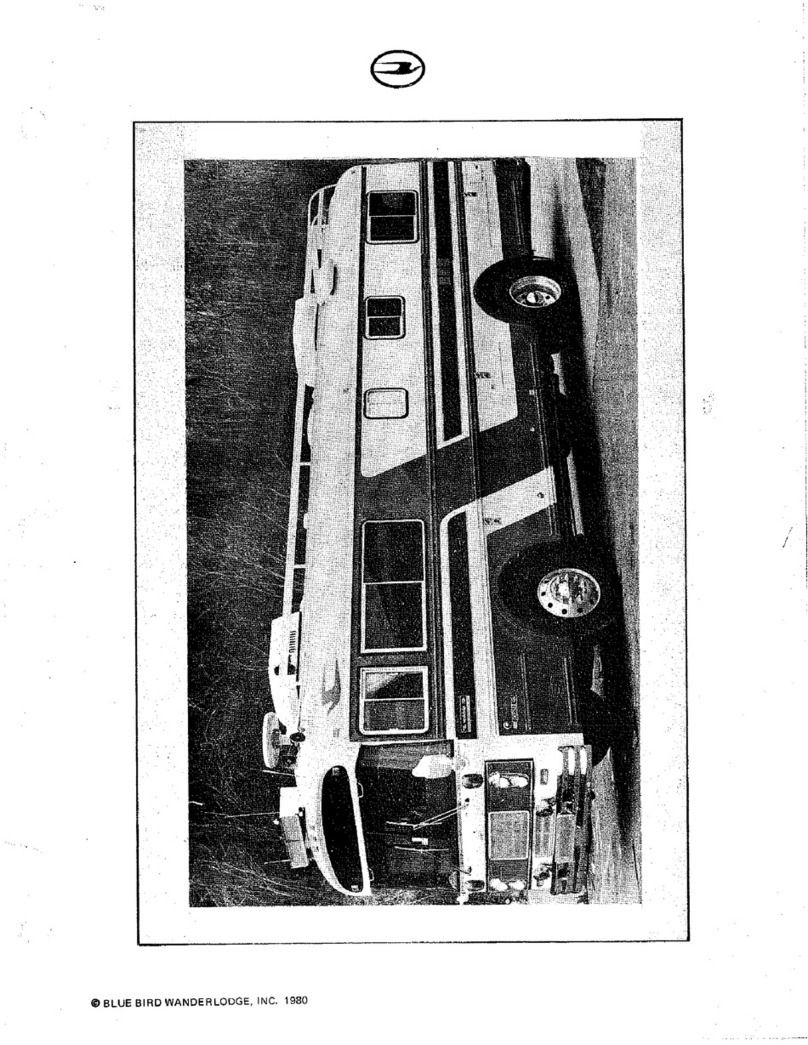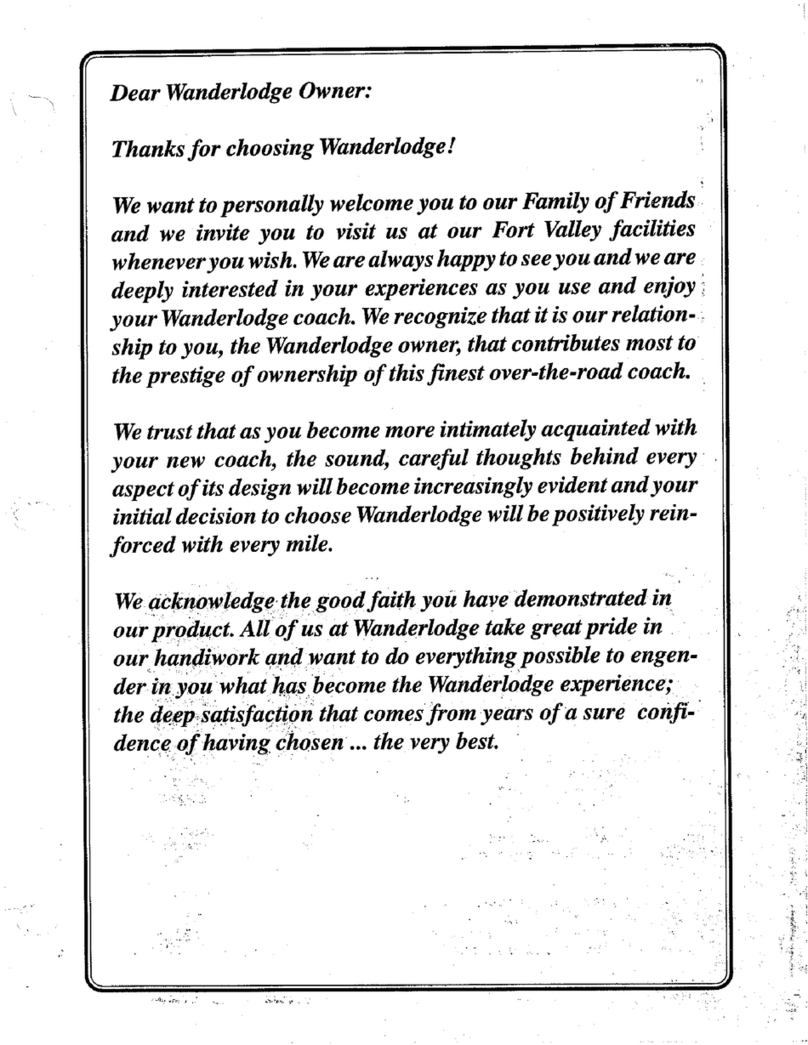
YOUR LIMITED WARRANTY ON YOUR NEW
wander lodge
Whoare the parties to this Warranty?
Blue Bird Wanderlodge, a division ofBlue Bird Body Com-
pany, gives this Warranty. The terms "we," "us," and "our"
in this Warranty refer to that division. The Warranty extends
to the owner of the Wanderlodge <t.The terms "you" and
"your" in this Warranty refer to the owner.
What parts are covered?
This Warranty covers all parts of the Wanderlodge e that
are made or bought by our factory and installed there, those
major power train components that are warranted from other
manufacturers are not covered by this Warranty, such as en-
gine, transmission and batteries . Those separate warranties
are contained in the owner's package furnished to you by your
dealer at the time ofdelivery. Our Warranty also does not in-
clude parts or accessories which you or your dealer bought or
install ed.
How long does this Warranty last?
36 months and/or 36,000 miles, whichever event is first to
occur, is the "Warranty Period." After the earlier of 24
month s/24,000 miles warranty coverage will be prorated ac-
cording to schedule below.
Parts & Labor
% Covered By W/L
Month aI Miles (thousands)
This warranty begins on the date the vehicle is delivered
to the first retail purchaser or first placed in service as a dem-
onstrator or company vehicle, whichever is ear lier. Mileag e
accumulated while in possession of the deal er is included in
the 36,000 mi:e total.
What repair expenses does the Warranty cover?
We will pay for all parts and labor needed to make neces-
sary repairs due to defects in factory materia l or workman-
ship (our payments after the ear lier of 24 month s or 24,000
miles will be prorated under the schedule set forth above).
You may have those repairs made by any author ized dealer
orany capable and reputable repair facility.
This Warranty does not cover maintenanc e services. You,
as the owner, must see that the Wanderlodge• is properly
maintained at your own expense. You must also pay for
maintenance items, such as wiper blades, oil, filters, bulbs,
antifre eze,brake linings, etc.
This Warranty also does not cover damage from things we
could have no control over like collision, misuse, negligence,
modifications and lack of maintenance . We do warrant that
when the Wanderlodge • left our factory it was free from de-
fects in factory material or workmanship. Repair or replace-
ment of defective parts is your exclusive remedy under this
Warranty.
Whomay make a claim under the Warranty?
Whoever owns the Wanderlodge • during the Warranty
Period may make a claim. In other words, the Warranty is
transferred automatically when the Wander lodge'"'is trans-
ferred.
What must the owner do to have defects repaired unde r
the Warranty?
You should promptly take your Wanderlodge e to the dealer
who sold it toyou or to the nearest Wanderlodgee dealer. (You
may obtain the name and address of the nearest dealer by
writing or calling us at the address and number set forth
below.) In the event there is some geographic or mechanica l
reason you cannot get to a Wanderlodge'!>dealer, you may
(with our approval) use any qi.pable and reputable repair fa.
cility. The dealer will make any needed repairs (or arrange
for them to be made) within a reasonable time after you de-
liver the vehicle to him. Youmust take the vehicle tothe deal-
er promptly after discovering the defect and, in any event,
within the Warranty Period.
You are responsible for properly operating, maintain ing
and caring for your Wanderlodge t in accordance with the in-
struct ions contai ned in your Owner's Manual.
You are responsible for keeping maintenance records,since
in some instances, it may be necessary for you to show that
proper maint ena nce hasbeen performed.
Where does the Warranty apply?
This Warranty applies to those Wanderlodges~ which are
legally registered and normally operated in the United States
or Canada. ·
What if a Warranty matter is not handled to the owne r's
satisfaction?
Let the dealer know ifyou are not happy with his treatment
of your claim. If you believe he hasn't treated you right, let
us know the details. Write directly tothe top:
General Manager
Blue Bird Wanderlodge
One Wanderlodge Way
Fort Valley,Georgia 31030
Whatdoes this Warranty not cover?
The preceding paragraphs describe everything that is
covered bythis Warranty.
Anything else isnot covered. Without limiting this general
state ment about what is not covered, we point out as exam-
ples that telephone calls, lossof time, commercial loss,incon-
venience, and loss ofuse ofthe vehicle, hotel or motel accomo-
dations, whether in the field or at the factory are not covered.
Similarly, equipment we do not manufacture or supply is not
covered, and material separately warranted by other man-
ufacturers is not covered. Nor does this Warranty cover any
part of the vehicle which fails or malfunctions as a result of
work by anyone besides us. Normal deterioration ofpaint and
trim from weather and exposure (and damage to paint and
trim after you accept delivery of the Wanderlodge-9)are not
covered.
Is there anything else important in this Warranty?
YES . ANY IMPLIF,I) WARRANTIES. INCLUDING THO SE OF MER-
CHANTARll ,ITY OR FITNESS, ARE LIMITED TO THE WARRANTY PERIOD
OF THI S WR\ITF,N WARRANTY. AND WE WlLL NOT BE LIABLE FOR INCI-
DENTAi. OR CONS EQUENTIAi. DAMAGES RESULTING FROM BREACH
OF THIS WRIITF.N WARRANTY OR ANY LMPLIED WARRANTY . Some
states do not allow limitation s on how long an implied war-
ranty will last, or the exclusion or limitation ofincidental or
consequent ial damages , so the above limitation s or exclu-
sions may not applytoyou.
This Warranty gives you specific legal rights and you may
also have other rights which vary from state to state.
Any lawsuit forbreach ofthis Warranty must be filedwith-
in one year ofbreach.
No one, includin g the dealer, is aut horized to modify this
Warranty or to make any other warranty on our behalf.There
is no other express warranty on this vehicle. To the extent al-
lowed by law, Georgia Law governs this Warranty and rights
arising hereunder .
BLUE BIRD WANDERLODGE • ONE WANDERLODGE WAY• FORTV ALLEY,GEORGIA,31030 • l912l825-2021









































